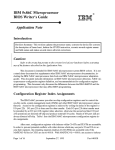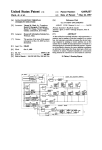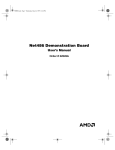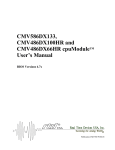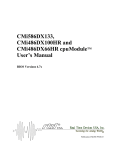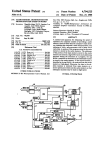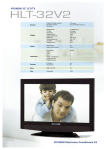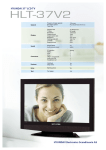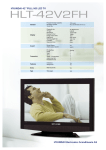Download Bus Snooping and the IBM 486 DX2/DX4 Microprocessor
Transcript
Bus Snooping and the
®
IBM 486 DX2/DX4 Microprocessor
Application Note
Author:
Scott Pheasant
Introduction
This paper explains the benefits of bus snooping and the differences among the IBM 486
DX2/DX4 revisions and the Intel® 486DX2.
Please note that discussions about the Intel proces-
sors with write-through cache refer to the original 486DX2 and the Write-Back Enhanced
486DX2 which is operating in write-through mode.
All write-back cache discussions reference
the Write-Back Enhanced 486DX2 processor.
Ever since the first computer was designed, engineers have been searching for ways to increase system speed or performance.
access to external memory.
One of the largest restrictions on system speed was slow
It simply took too long to perform writes and
reads to and from
memory that was limited by system bus speed and memory control logic.
The solution that is now a standard in microprocessors is the design of an "on-chip" memory that is much faster than external memory.
cache.
This memory is known as cache memory, or simply
Cache size is much smaller than external memory, but allows for a quick storage space for
most software applications' source code.
With the invention of this quick memory, however, also
came the problem of keeping external memory updated with changes that occur within the cache;
this is termed "maintaining cache coherency."
the cache contents to external memory.
Write-through cache solves this by always writing
A write-back cache system solves this by only writing
those cache lines that have been updated ("dirty" cache lines) out to external memory.
A similar problem occurs when the processor is in a "held" state and other devices are updating external memory.
In this case, cache will be inconsistent with external memory.
tion for this circumstance is called bus snooping.
This method allows the external memory
manager to invalidate cache addresses that are being updated in external memory.
bus snoop cycle begins with an assertion of
the processor to tri-state its address bus.
The solu-
In general, a
AHOLD, HOLD, or BOFF# by the system to force
The system then asserts EADS# to drive the modified
address into the processor to allow for cache invalidations.
Snooping does not enhance perform-
ance or reduce the final product's cost, it simply insures that data integrity is maintained within the
processor so feasible application errors can be reduced.
Depending on the type of cache and the
processor you are using, snooping is implemented and initiated differently.
Page 1 of 5
October 12, 1995
Fax #40017
Snooping with Write-Through Cache - Intel & IBM
Both Intel's and IBM's 486 DX2/DX4 microprocessors have two methods for initiating
snooping:
1
a software method and a hardware method.
For an Intel processor, the software method of performing a bus snoop is initiated by the
issuing of a HLT (halt) instruction.
When a software application issues a HLT instruction, the
SL-Enhanced 486DX2 processor will automatically enter into a Power Down state.
While the
microprocessor is in this state, however, other devices which share the memory space with the
processor may still be making changes to the external memory.
To insure that the processor's
cache is coherent with system memory, bus snooping (cache line invalidations) occurs.
As previ-
ously explained, AHOLD, HOLD, or BOFF# is asserted followed by an EADS# to perform the
snoop.
In write-through mode, if the address that is driven with the EADS# into the processor is
found within the processor's cache, it will be invalidated immediately.
The software method for snooping in an IBM processor is very similar to that of the Intel
part.
The biggest difference on the IBM processor, however, is the feature which allows a user
the option of automatically suspending on a HLT instruction or not suspending on a HLT instruction.
If bit 3 in the IBM's CCR2 register is set to a logic '1', then the CPU will automatically sus-
pend whenever a HLT instruction is encountered.
Otherwise, the IBM CPU operates as the Intel
processor.
It is extremely important that the user understand which revision of the IBM microprocessor is being used for a particular application.
Appendix B of the IBM Blue Lightning 486 DX2
Data Book explains the coding which is used for ordering specific processor revisions.
If your or-
der number does not have the code letter which identifies a revision, the part in question is of a revision which is previous to revision 4.2.
IBM parts prior to revision 4.2 do not snoop whenever
an automatic suspend on HLT is executed.
Beginning with revision 4.2, all subsequent revisions
will snoop when CCR2 register, bit 3, is set to a logic '1'.
The section entitled "Write Through Cache Coherency and the IBM Blue Lightning 486
DX2" covers solutions to possible data inconsistencies between the on-board cache and external
memory.
As mentioned, there is also a hardware method for forcing bus snooping.
If an Intel proc-
essor is in a stop grant state (the internal processor clock is electronically stopped after the assertion of the STPCLK# pin), then the processor will snoop on modified addresses.
If the processor
enters into system management mode, by the assertion of the SMI# pin, the processor is placed
into a state which allows
AHOLD, HOLD, BOFF#, and EADS#
to continue functioning for bus
snooping.
On an IBM processor, the SUSP# pin is used to place the processor in its suspended mode
(if bit 7 of CCR2 register is set to a logic '1').
1
However, no revision of the IBM 486 DX2/DX4
See items 2 and 5 in the References section at the end of this document for sources per-
taining to snooping with write-through cache.
Page 2 of 5
October 12, 1995
Fax #40017
processor allows for snooping during this hardware-initiated suspend mode.
System Management
mode snooping for an IBM processor occurs just as with the Intel CPU.
Snooping and Write-Back Cache - Intel and IBM
The hardware and software methods of entering the different modes which trigger bus
snooping are the same for a write-back cache as they are for the write-through cache.
The actual
implementation of the cache invalidations (bus snooping), however is a little different.
With Write-Back cache enabled, both the Intel 486DX2 microprocessor and the IBM mi-
2
croprocessor function very similarly.
is asserted, followed by EADS#.
When a snoop cycle occurs,
AHOLD, HOLD, or BOFF#
If the address being snooped is found within the internal cache,
that particular line is first checked to see if the data is dirty.
data is written to external memory and then marked invalid.
If the data in the cache is dirty, the
If the cache line does not contain
dirty data, that line is marked invalid.
Regardless of the cache mode which is being utilized, the IBM processor revision level is
again extremely important.
pend mode.
pin)
Revisions previous to rev 4.2 will not initiate snooping during sus-
This includes both the software (automatic suspend on HLT) and hardware (SUSP#
methods of implementing suspend mode.
Beginning with rev 4.2 and above, whenever the
automatic suspend on HLT bit (bit 3 of CCR2) is set, snooping will occur when the HLT instruction is executed.
As with the other revisions, however, when using the SUSP# pin for suspend
mode, snooping will not occur.
Snooping on both IBM and Intel CPUs always occurs during SMM mode.
Write-Through Cache Coherency and the IBM 486
DX2/DX4
When using an IBM processor, there are some instances when the processor will be placed
into a "held" state to allow external devices direct control to the system memory, yet bus snooping will not occur.
It is these cases in which cache coherency can become a real problem if system
hardware or software is not designed properly.
In revisions 4.1 and below, no snoop will occur on any suspend cycles.
3
On revisions 4.2
and above, snooping will only occur when automatic suspend on HLT is initiated.
If the IBM
processor is set up for an automatic suspend on HLT (CCR2 register, bit 3, is set to logic '1') and
a user is writing software code to be used on the processor, it is required that a WBINVD (Writeback Invalidate) instruction be issued before the implementation of the HLT instruction.
WBINVD instruction will flush all cache data
state.
2
The
before placing the processor into a suspended
This will ensure that, when the processor is brought out of suspend mode, the cache will
See items 2 and 5 in the References section at the end of this document for sources per-
taining to snooping and write-back cache.
3
See item 5 in the References section at the end of this document
Page 3 of 5
October 12, 1995
Fax #40017
have clean data because the CPU will be required to access external memory for the cache lines
that were invalidated.
If a system user is using pre-written software, it is recommended that the
CCR2 register, bit 3, be set to a logic '0' so that an automatic suspend on a HLT instruction will
never occur.
In hardware, the logic designer should force the processor's FLUSH# pin to be asserted
first whenever a SUSP# pin assertion is requested.
This will create the same results as the execu-
tion of a WBINVD instruction before a suspend on HLT instruction.
Write-Back Cache Coherency and the IBM 486 DX2/DX4
As with a write-through cache, bus snooping will not always occur when the processor is
suspended, which could cause cache-memory inconsistencies.
The same methods described in the "Write-Through Cache Coherency and the IBM Blue
Lightning 486 DX2/DX4"
section of this paper are also true for this processor configuration.
References:
1. IBM 486 DX2 Addendum to the IBM Blue Lightning 486 DX2 Databook, August 11,
1995
2. Intel 486 Microprocessor Family Databook, 1994
3. Enhanced Am486 Microprocessor Family Datasheet, May, 1995
4. IBM 486 DX4 Addendum to the IBM Blue Lightning 486 DX2 Databook, September 12,
1995
5. IBM Blue Lightning 486 DX2 Databook, 1994
6. IBM Blue Lightning Microprocessor Datasheet, February 7, 1994
7. Pentium Family User's Manual, 1994
Page 4 of 5
October 12, 1995
Fax #40017
IBM Corporation 1995. All rights reserved.
IBM and the IBM logo are registered trademarks of International Business Machines Corporation. IBM Microelectronics is a trademark of the IBM Corp.
All other product
and company names are trademarks/registered trademarks of their respective holders. 1995
IBM Corp.
This document may contain preliminary information and is subject to change by IBM without notice. IBM
makes no representations or warranties that the use of the information or applications herein shall be free of
third party intellectual property claims and assumes no responsibility or liability from any use of the information contained herein. Nothing in this document shall operate as an express or implied license or
indemnity under the intellectual property rights of IBM or third parties.
The products described in this document are not intended for use in implantation or other direct life support
applications where malfunction may result in physical harm or injury to persons.
NO WARRANTIES OF ANY KIND, INCLUDING BUT NOT LIMITED TO THE IMPLIED WARRANTIES
OF MERCHANTABILITY OR FITNESS FOR A PARTICULAR PURPOSE ARE
OFFERED IN THIS DOCUMENT.
All performance data contained in this publication was obtained in a specific environment, and is presented as
an illustration. The results obtained in other operating environments may vary.
Page 5 of 5
October 12, 1995
Fax #40017





